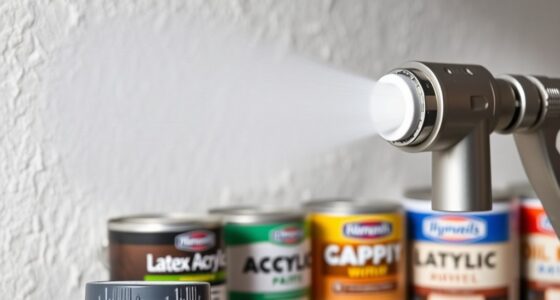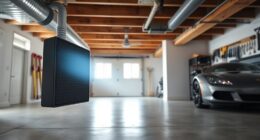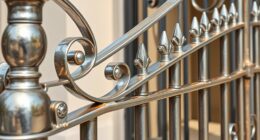Many myths about airless paint sprayers, like being too expensive, complex, or only suitable for big projects, aren’t true. Modern models are affordable, easy to operate, and perfect for small or detailed work. Proper technique minimizes overspray, and you don’t need special paints to get the job done. If you want to challenge these misconceptions and discover how versatile and user-friendly airless sprayers really are, there’s more to explore.
Key Takeaways
- Airless sprayers are affordable and cost-effective, especially for large or frequent projects, contrary to the myth they are too expensive.
- Modern airless sprayers are easy to operate with simple setup and ergonomic features, making them accessible for DIY users.
- Proper technique and adjustments effectively control overspray and waste, dispelling the idea that these sprayers are messy or uncontrollable.
- They are suitable for both small touch-ups and large projects, offering versatility beyond just big-scale painting jobs.
- Compatibility with various paints, including specialty and textured options, ensures no need for proprietary products or modifications.
Airless Sprayers Are Too Expensive for DIY Use

Many people believe that airless paint sprayers are too expensive for DIY projects, but this isn’t always the case. When you do a cost comparison, you’ll find that the initial investment can be reasonable, especially considering the time and paint savings. Budget considerations play a key role—if you plan to paint frequently or on large surfaces, an airless sprayer could be more cost-effective in the long run. Renting a sprayer for a weekend might be cheaper than hiring a professional or buying a traditional roller and brush setup. Additionally, the quality and efficiency of airless sprayers reduce waste and improve finish, saving you money on materials. Proper maintenance and cleaning of these sprayers also extend their lifespan, making them a worthwhile investment. So, don’t dismiss airless sprayers as too expensive before exploring your options and evaluating your project needs.
Operating an Airless Sprayer Is Too Complex for Beginners
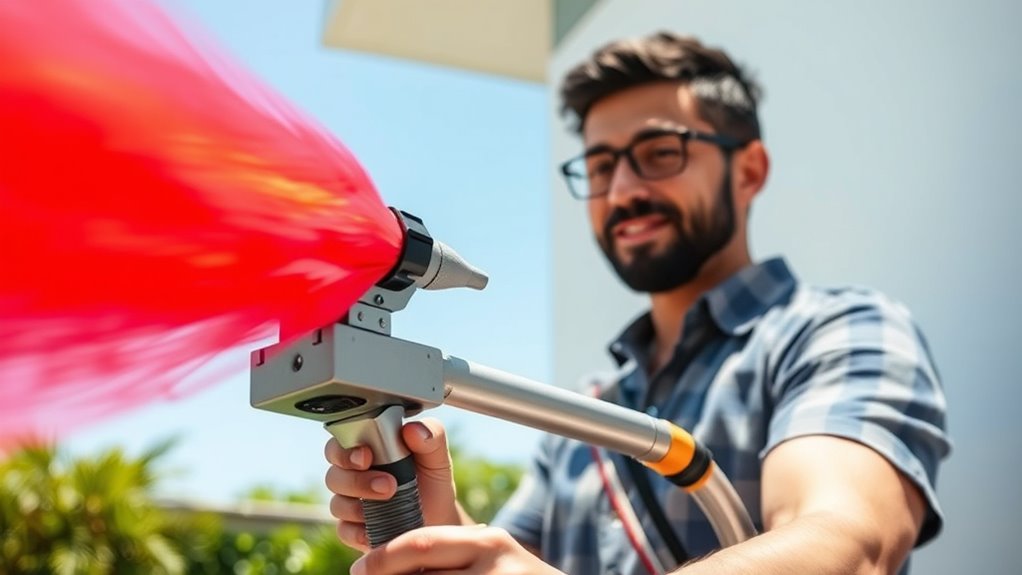
Many beginners assume operating an airless sprayer is complicated, but it’s actually quite straightforward. The setup process is simple, and the controls are designed to be user-friendly. With a quick learning curve, you’ll be spraying confidently in no time. Additionally, proper maintenance and troubleshooting are manageable when you understand the common issues and troubleshooting steps.
Simple Setup Process
Although some assume that setting up an airless paint sprayer is complicated, the process is straightforward once you understand the basic steps. You just need to connect the hose, prime the system, and adjust the pressure. To guarantee a smooth experience, keep these tips in mind:
- Follow maintenance tips to prevent clogs and prolong your sprayer’s lifespan
- Always wear safety precautions, like goggles and masks, during setup
- Check for leaks or loose connections before starting
- Understanding sprayer operation can help you troubleshoot common issues more efficiently
User-Friendly Controls
While some people believe operating an airless paint sprayer is overly complicated, the controls are actually designed to be user-friendly. Modern sprayers feature intuitive control panels that simplify tasks like sprayer calibration and adjusting spray patterns. With clearly labeled buttons and dials, you can easily set the pressure and flow rate without confusion. Here’s a quick overview:
| Control Feature | Function |
|---|---|
| Power Switch | Turns the sprayer on/off |
| Pressure Dial | Adjusts spray pressure |
| Spray Pattern Selector | Changes spray width |
| Calibration Mode Button | Ensures accurate sprayer settings |
| Flow Control Lever | Regulates paint flow |
These controls make it straightforward for beginners to operate confidently and efficiently. Additionally, color accuracy in modern projectors is designed to be as intuitive as these controls, making setup and adjustments accessible even for novices.
Quick Learning Curve
Some assume that operating an airless paint sprayer is too complicated for beginners, but in reality, the learning curve is manageable. With a little practice, you’ll quickly develop the skills needed to use it effectively. The key is understanding basic functions and techniques, which can be learned through simple tutorials or hands-on experience. As you gain confidence, your skill development accelerates, making the process smoother. To help you get started, focus on these essentials:
- Proper setup and safety checks
- Maintaining consistent spray patterns
- Adjusting pressure for different surfaces
- Familiarizing yourself with Glycolic Acid benefits for skin and application techniques
Most beginners find that once they familiarize themselves with these fundamentals, handling an airless sprayer becomes straightforward and efficient, dispelling the myth that it’s too complex for newcomers.
Airless Spray Painting Results in Excessive Overspray
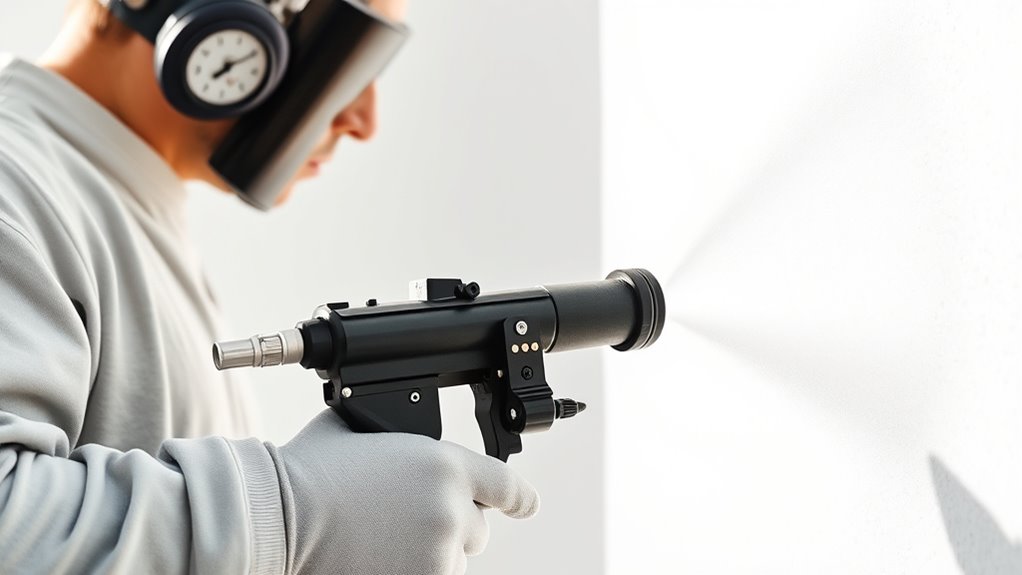
Many people believe that airless spray painting produces excessive overspray, which can lead to wasted paint and messy workspaces. However, with proper technique, this isn’t true. Precision adjustment of your spray tip and pressure settings allows you to control the paint atomization process, reducing overspray considerably. When you fine-tune your equipment, you ensure a consistent spray pattern, minimizing paint drift and overspray. Correct distance from the surface and steady movement also help contain the spray, preventing messes. Instead of fearing waste, focus on adjusting your sprayer correctly. Modern airless sprayers are designed for efficiency and control. Proper setup and technique are key to achieving clean, professional results without the common myth of excessive overspray. Additionally, understanding how to adjust pressure and spray pattern can significantly improve your results and minimize waste.
Airless Paint Sprayers Can Only Be Used for Large Projects
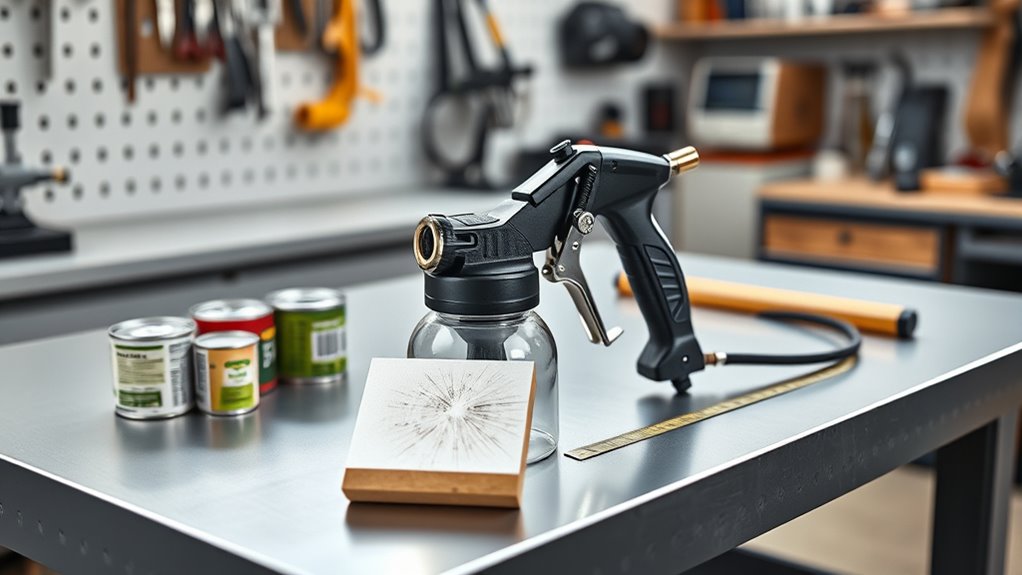
Many believe airless paint sprayers are only suitable for big jobs, but they’re actually great for small tasks too. You can easily use them for touch-ups or painting furniture without hassle. Even in apartments, they offer a quick and clean way to get professional results.
Versatility for Small Tasks
Although airless paint sprayers are often associated with large projects, they are actually quite versatile for small tasks as well. Their precision control allows you to handle detailed work with accuracy, ensuring clean edges and smooth finishes on smaller surfaces. The portability advantages mean you can easily move the sprayer around tight spaces or compact areas without hassle. This makes them ideal for projects like furniture, cabinets, or touch-ups. You can quickly switch between different jobs without needing multiple tools. Plus, their adjustable settings give you control over the spray pattern and flow rate, perfect for small, precise applications. Overall, airless paint sprayers aren’t just for big projects—they’re a handy, efficient option for smaller tasks too. Incorporating natural materials like wood and linen can further enhance the quality of your painted surfaces and overall project results.
Ease of Use in Apartments
You might think airless paint sprayers are too bulky or complicated for apartment use, but that’s a misconception. Modern models are designed with apartment convenience in mind, offering a compact design that fits easily into smaller spaces. Their lightweight construction makes them simple to handle, even in tight areas, and they’re easy to set up and clean. You don’t need a large workspace or extensive preparation to get professional results. Whether you’re touching up a wall or refinishing furniture, an airless sprayer can be a practical tool for apartment projects. Its ease of use saves you time and effort, proving that these sprayers aren’t just for big jobs—they’re perfect for small, quick tasks too. Additionally, understanding Gold IRA Rollovers can help diversify your investment portfolio for long-term security.
They Require Special, Hard-to-Find Paints
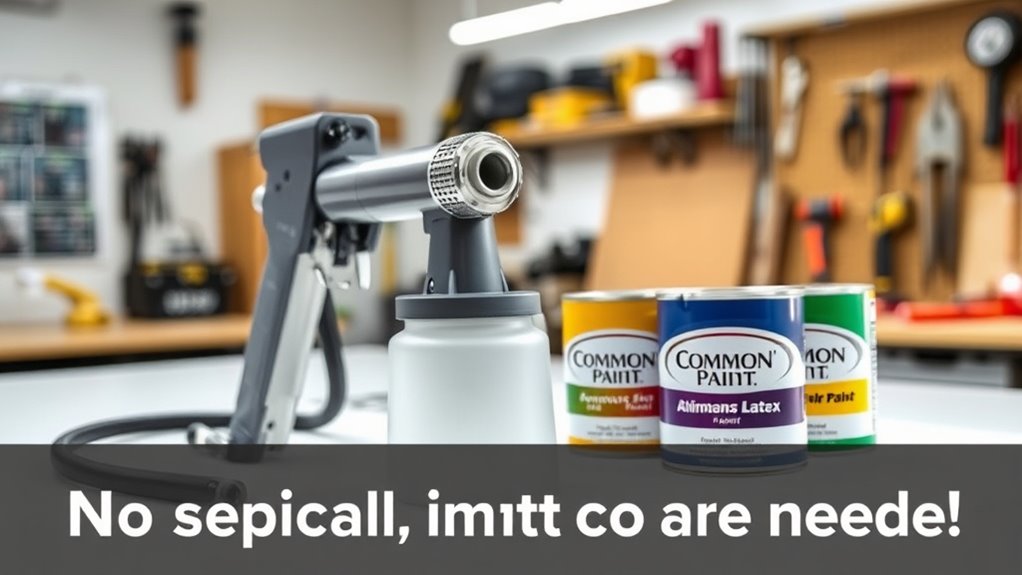
Airless paint sprayers do not actually require special, hard-to-find paints, despite what some myths claim. You can use regular latex or oil-based paints without issues. In fact, they work well with a variety of coatings, including those with specialty paints or custom colors. This flexibility means you don’t need to hunt for rare products or modify your paint for compatibility. Additionally, understanding the artistic versatility of paint types can help you select the best coating for your project.
Here are some key points:
- Standard paints work seamlessly with airless sprayers.
- You can use custom color formulations without problems.
- Specialty paints, like textured or low-VOC options, are compatible too.
This versatility makes airless sprayers a practical choice for many projects, without the hassle of sourcing unique paints.
Airless Sprayers Are Too Heavy and Difficult to Handle
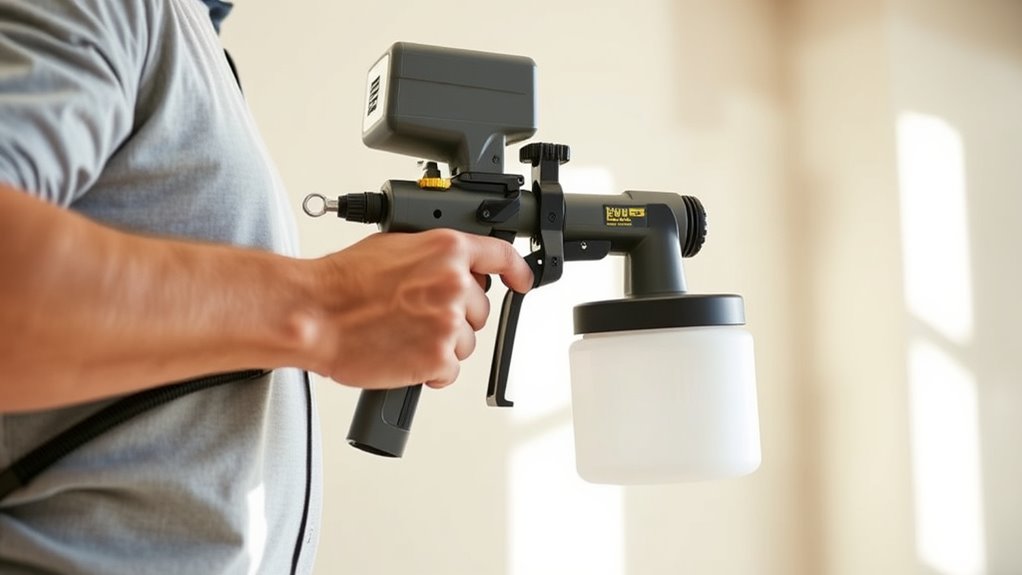
Many people worry that airless sprayers are too heavy and hard to control, but modern models are designed with user comfort in mind. When considering weight considerations, manufacturers focus on ergonomic design to make handling easier. These sprayers often feature balanced weight distribution and lightweight materials, reducing fatigue during extended use. The ergonomic design includes padded grips and adjustable straps, helping you maintain control without strain. Advances in technology have also led to more compact, lighter units that are easier to maneuver. With proper technique and the right equipment, you’ll find that operating an airless sprayer isn’t as difficult as it seems. Additionally, best ergonomic features ensure that users can operate these tools comfortably for longer periods. The improved weight considerations and ergonomic features make these tools accessible for both professionals and DIY enthusiasts.
Frequently Asked Questions
Can Airless Sprayers Be Used for Detailed or Small-Scale Projects?
You might wonder if an airless sprayer is suitable for detailed or small projects. While they excel at covering large areas quickly, they can also provide good precision detail with proper technique. For small projects, you’ll want to adjust the spray tip and pressure settings to achieve a fine finish. With some care, an airless sprayer can handle small projects effectively, giving you smooth, professional results even in tight spaces.
Do Airless Paint Sprayers Require Regular Maintenance or Cleaning?
Yes, airless paint sprayers need regular maintenance and cleaning. You should follow maintenance tips like flushing the system after each use and inspecting parts for wear. Cleaning routines include removing and cleaning the spray tip, filters, and hoses to prevent clogs and guarantee peak performance. Neglecting these steps can lead to poor spray quality and damage, so make sure to keep up with routine maintenance for long-lasting, efficient spraying.
Are There Eco-Friendly or Low-Voc Options for Airless Sprayer Paints?
Ever wondered if you can use eco-friendly paints or low VOC options with your airless sprayer? The good news is, yes! Many brands now offer eco friendly paints that are compatible with airless sprayers, reducing harmful emissions and environmental impact. Low VOC options help improve indoor air quality while still delivering excellent coverage. So, you can achieve your painting goals while being kind to the planet. Isn’t that a win-win?
How Long Does It Typically Take to Learn Proper Airless Spray Techniques?
Learning proper airless spray techniques usually takes some practice, but your techniques mastery can develop quickly with dedicated effort. Typically, you’ll see progress within a few hours of practice, though full proficiency might require around 10-15 hours of hands-on experience. The key is consistent practice duration, focusing on controlling spray distance and speed. Keep practicing regularly, and you’ll gain confidence and precision faster than you expect.
What Safety Precautions Should Be Taken When Operating an Airless Sprayer?
When operating an airless sprayer, you should always wear personal protective equipment like goggles, masks, and gloves to protect yourself from paint and fumes. Guarantee proper ventilation to avoid inhaling harmful vapors. Keep the area well-ventilated, use fans if needed, and follow manufacturer instructions. Taking these safety precautions helps prevent health issues and ensures a safer, more effective painting experience.
Conclusion
Don’t let these myths hold you back from trying an airless sprayer. With modern designs, they’re more affordable, user-friendly, and versatile than you think. Whether you’re tackling a small project or a big one, you’ll find it easier than you imagined. So, why miss out on achieving smooth, professional-looking results just because of misconceptions? Give it a shot—you might be surprised how simple and rewarding it can be to bring your vision to life.




